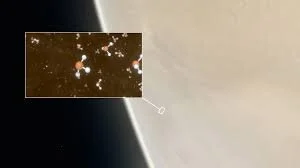This week’s post covers ultralight axions and galaxy clustering, using heavy elements to probe inelastic dark matter, and constraining primordial black holes from the dynamics of Neptune. Enjoy!
Top arXiv papers from Week 14, 2021
This week’s post is devoted to the search of Jupiter’s lightning bolts (aka gamma-rays from dark matter), the construction of new astrophysically-motivated black hole mass function and subsequent search for the black hole mass gap, and a (unusual for this blog, I know!) philosophical discussion on the anthropic principle.
Top arXiv papers from Week 10, 2021
After being “away” a few weeks where I used this blog as a conference diary (see TMCC2021 and A (Hubble) Tension Headache), the usual arXiv posts return, covering primordial black holes as (not) dark matter, difficulties in constructing working and realistic early dark energy models, and biases to parameter constraints from the effect of baryonic feedback on the gravitational lensing of the CMB. Enjoy the read!
Top arXiv papers from Week 49, 2020
Top arXiv papers from Week 46, 2020
This week’s entry deals with new measurements of the Deuterium-to-Helium-3 cross-section with extremely important implications for Big Bang Nucleosynthesis, and two papers on axion-photon conversion (and vice-versa) in astrophysical environments. A heads-up that next week’s blog installment will likely be cancelled due to personal reasons (see here). Enjoy!
Top arXiv papers from Week 45, 2020
Top arXiv papers from Week 44, 2020
This week I cover a rebuttal against the claims of having detected phosphine (possibly connected to life) on Venus, a proposal for solving the core-cusp problem using late-time dark matter oscillations, and how self-interacting dark matter could provide the seeds for the observed supermassive black holes. This week I've found it particularly important to repeat a few important caveats: my covering particular papers does not necessarily mean I endorse the science or the writing style, just that I found the paper particularly interesting (it may even be directly outside my field of research). In other words, your mileage may vary, so don’t forget to take whatever you read here with a grain of salt. One thing I’m starting to do from this week on is to explicitly point out when a certain paper has been signed alphabetically (which is often the case within hep and gr-qc), in an attempt to hopefully give more visibility to early-career physicists whose last name initials, due to no fault of their own, reside in the second half of the alphabet.
Top arXiv papers from Week 39, 2020
Top arXiv papers from Week 27, 2020
Top arXiv papers from Week 24, 2020
This week’s entry discusses a new measurement of the Hubble constant from Type II Supernovae, a map from Poincaré gauge theories to bi-scalar-tensor theories useful for cosmological applications, and a map between fluid and field approaches to interacting dark energy valid at the background and first-order perturbation level.










